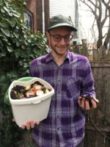Today I was wondering about how waste is collected in different parts of the country, especially during this wintry time of year. The featured article below just came out showing support for a composting program taking place in Alaska.
The composting process is conducted indoors (“in vessel”) due to cold outside temperatures that make it tricky to maintain an active compost pile. As a result, it allows for quite a great deal of waste to avoid the landfill year round.
This is some great news for the folks in Alaska. Although it’s a wild guess, maybe the colder temperatures tend to keep most people from starting their own composting efforts. If this is the case, it’s even more imperative to enhance in vessel composting programs.
original source: http://www.wasterecyclingnews.com/article/20121217/NEWS01/121219930/composting-method-used-to-combat-the-cold
Anchorage, Alaska — The large drum slowly spins around at Alaska Waste’s headquarters, taking in a grinded mixture of produce, woodchips and horse manure on one side and spitting out finished product on the other.
This is composting, Alaska style, which helps divert about 10 tons of material each week from the local landfill.
Colder temperatures make traditional composting a challenge, and that’s why Alaska Waste turned to an in-vessel approach approximately four years ago.
“The reason for that is because of size and also because of where we are,” said Mike Shrewsbury, who helps oversee the company’s composting and biodiesel operations. “The cold of Alaska, you can produce compost through windrows, but because of that cold you really have to be temperature conscious. If your compost becomes too cold, it will stop digestion and decomposition.”
Putting compost in the unit, which is 30 feet long and has a 10-foot diameter, helps maintain a constant temperature and environment that can be adjusted as needed.
The footprint of the composting machine also allows that work to be located in a building at the company’s Anchorage headquarters.
“This is much more compact than having a lot of windrows that take up a lot of land,” Shrewsbury said. “It’s really the size and the environment, why we went with the in-vessel composting.”
Raw materials are placed in the vessel five days a week and finished compost is removed five days a week. The material sits for 23 hours a day and then turned for an hour. After seven days, the finished product is removed via conveyor belt. The vessel is situated at a 1-degree angle, allowing material to work its way through the vessel during the week before it’s ready to come out of the finished end.
“It’s really key to maintain a constant level of compost in there to maintain the microorganism colonies that are required,” Shrewsbury said.
Alaska Waste, owned by Waste Connections Inc., has one customer that takes all of the compost, Green Earth Landworks LLC, which puts the material into composting socks for erosion control for landscape construction projects. These permeable socks allow water filtration to deliver nutrients from the compost to areas in danger of erosion, such as roadsides, Shrewsbury explained.
